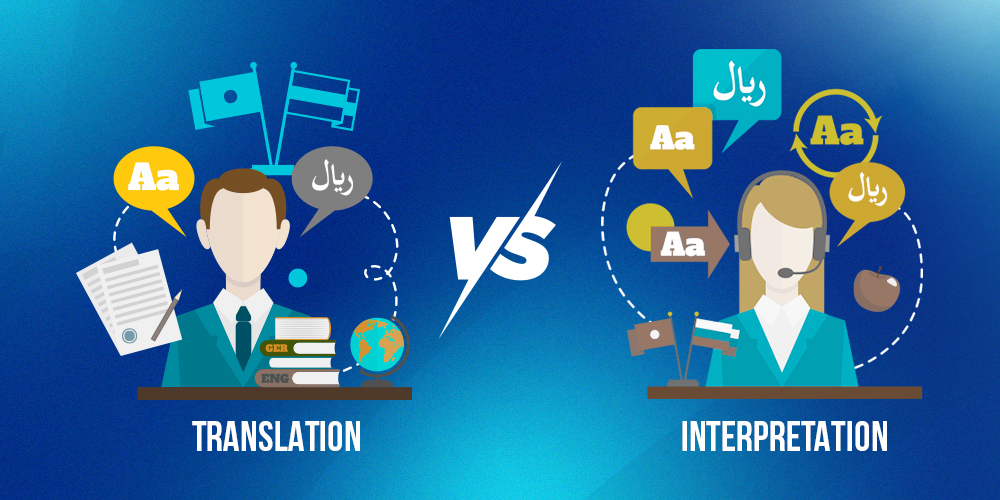
Language bridges worlds. Whether in international business, diplomacy, legal matters, or healthcare, understanding each other is vital. But how do we make communication possible between people who speak different languages? The answer often lies in two distinct yet interconnected professions: translation and interpretation. While many use these terms interchangeably, there are critical differences between them. So, let’s dive into the question: What is the difference between translation and interpretation?
What is Translation?
To begin with, let’s define what translation really is. Simply put, translation is the process of converting written text from one language into another. It is a meticulous task that requires the translator to maintain the original meaning, style, tone, and intent of the source text.
What is translation, then, beyond the surface level? It’s more than word-for-word substitution. It involves cultural nuance, deep linguistic understanding, and often subject-matter expertise. Translators usually work with documents such as books, manuals, contracts, marketing materials, websites, and more. Because they’re working with written content, translators have the luxury of time—time to consult dictionaries, research terminology, and revise their work to ensure accuracy.
Furthermore, translation is not limited to common language pairs. A Certified Translation Company in Michigan, for instance, might offer services in over 100 languages, ensuring legal or medical documents are accurately converted and accepted by institutions.
What is Interpretation?
On the other hand, interpretation refers to the real-time conversion of spoken words from one language to another. It is dynamic, immediate, and often happens on the spot. Interpreters work in situations like courtrooms, conferences, hospitals, and international meetings.
So, what is the interpretation exactly? It’s the verbal equivalent of translation, but with higher stakes in terms of immediacy. Interpreters don’t have the time to consult dictionaries or edit their output. Instead, they rely on memory, deep familiarity with both languages, quick thinking, and cultural competence. There are several types of interpretation, such as simultaneous (spoken in real-time), consecutive (spoken after the speaker pauses), and whispered (spoken quietly to one or two people).
Moreover, Multilingual Interpretation is increasingly in demand in a globalized world. Whether it’s in virtual business meetings or humanitarian missions, being able to interpret across multiple languages is a skillset that adds immense value.
Translation vs Interpretation: The Core Differences
Now that we’ve clarified the two terms individually, let’s explore the key contrasts in the translation vs interpretation discussion. Despite sharing the common goal of language conversion, the skillsets, tools, and workflows involved are notably different.
1. Medium: Written vs. Spoken
The most obvious distinction is that translation deals with the written word, whereas interpretation focuses on spoken communication. This difference shapes everything about how each profession functions.
2. Timing: Deferred vs. Immediate
Translators often have the benefit of time. They can review, revise, and refine their work. Interpreters, by contrast, must operate in real-time, meaning there’s little to no margin for error. One misinterpreted phrase can lead to confusion—or worse—in high-stakes environments like hospitals or courtrooms.
3. Tools and Environment
Translators use CAT (Computer-Assisted Translation) tools, dictionaries, and style guides to aid their work. They can work remotely and at their own pace. Interpreters, however, may work on-site or via remote video/phone platforms, and must rely on memory, note-taking, and sometimes headsets or booths for simultaneous interpretation.
4. Skillset and Training
The interpreter vs translator debate often centers on which profession is “harder.” The truth is, both demand extensive training, but in different areas. Translators need writing proficiency, research skills, and grammatical expertise. Interpreters need excellent listening skills, mental agility, and public speaking confidence.
Looking for interpretation that makes communication effortless?
We connect people with clarity, ensuring every detail is understood. From healthcare to business to law, our interpreters make every conversation effortless.
Situational Examples: Translation vs Interpretation in Action
To further illustrate these differences, let’s look at some real-world examples.
- Legal Sector: A contract being sent overseas for review requires a translator to ensure every clause is accurately rendered. However, a court hearing involving a non-English speaker will require an interpreter to communicate statements between the judge, lawyers, and defendant instantly.
- Healthcare: A medical brochure or consent form would be translated to accommodate diverse patient populations. In contrast, during a doctor-patient consultation, an interpreter might be brought in to ensure accurate and empathetic communication.
- International Business: A Certified Translation Company in Michigan might handle translating product manuals for global distribution. But when hosting a virtual meeting with stakeholders in five different countries, Multilingual Interpretation services ensure everyone stays on the same page—literally and figuratively.
Interpretation in Multiple Languages: A Growing Need
As globalization accelerates, the demand for Interpretation in Multiple Languages continues to grow. No longer is bilingualism enough. Organizations now seek professionals who can interpret in three, four, or more languages, often in high-pressure environments. From global summits to disaster relief efforts, these interpreters are critical in connecting communities.
Simultaneously, the expansion of digital platforms has increased accessibility to interpretation services. Remote interpretation tools allow for real-time communication across continents. This has opened up new opportunities, but also new challenges—interpreters must now be tech-savvy as well as linguistically skilled.
Choosing the Right Service: Interpretation or Translation?
When deciding between translation vs interpretation, context is key. Ask yourself:
- Is communication written or spoken?
- Is accuracy more important than speed, or vice versa?
- Will the audience consume the content now or later?
- Are there legal or official requirements (e.g., certified translation)?
If you’re unsure, a professional agency can help determine what is needed. For example, a Certified Translation Company in Michigan might offer both services under one roof, guiding clients through complex multilingual projects.
The Interdependence of Translation and Interpretation
Despite their differences, translation and interpretation often go hand-in-hand. For instance, at a global conference, you might find interpreters translating speakers in real-time while a team of translators works behind the scenes to prepare transcripts, promotional materials, or follow-up reports.
Moreover, many professionals develop skills in both areas. However, most choose to specialize due to the unique demands of each person. Mastering both disciplines is rare but incredibly valuable, especially in international diplomacy or major multinational organizations.
The Human Element in Language Services
One vital point to remember is that both translators and interpreters do more than just convert words—they convey meaning. They bridge cultural gaps, preserve nuances, and ensure mutual understanding. This is something even the most advanced AI tools have yet to fully replicate.
Whether it’s interpreting a heartfelt testimony or translating a piece of literature, these professionals ensure the message doesn’t get lost in translation—or in interpretation.
Looking for interpretation that makes communication effortless?
We connect people with clarity, ensuring every detail is understood. From healthcare to business to law, our interpreters make every conversation effortless.
Final Thoughts: Bridging the Gap
So, returning to our central question—What is the difference between translation and interpretation?, the answer lies in the medium, method, and mindset. One is written, the other sis spoken One is reflective, the other immediate. Yet both are indispensable in a world where communication is more global and more essential than ever. Understanding the nuances in the interpreter vs translator discussion can help you make better decisions—whether you’re hiring a language expert or considering a career in the field.
With services like Multilingual Interpretation and support from a Certified Translation Company in Michigan, individuals and organizations alike can ensure their message is heard and understood—no matter the language. In the grand comparison of translation vs interpretation, it’s clear that while they serve similar goals, they do so in remarkably different ways. Recognizing and respecting those differences is the first step in achieving true global communication.

